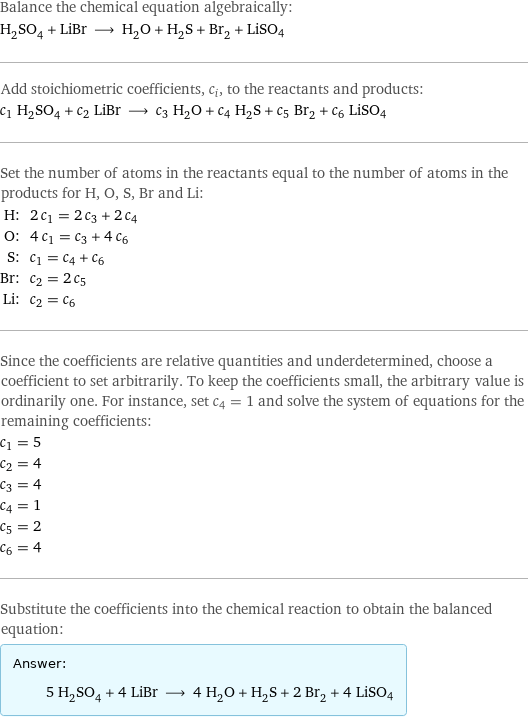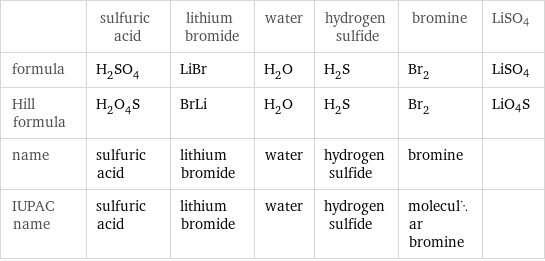Input interpretation

H_2SO_4 sulfuric acid + LiBr lithium bromide ⟶ H_2O water + H_2S hydrogen sulfide + Br_2 bromine + LiSO4
Balanced equation

Balance the chemical equation algebraically: H_2SO_4 + LiBr ⟶ H_2O + H_2S + Br_2 + LiSO4 Add stoichiometric coefficients, c_i, to the reactants and products: c_1 H_2SO_4 + c_2 LiBr ⟶ c_3 H_2O + c_4 H_2S + c_5 Br_2 + c_6 LiSO4 Set the number of atoms in the reactants equal to the number of atoms in the products for H, O, S, Br and Li: H: | 2 c_1 = 2 c_3 + 2 c_4 O: | 4 c_1 = c_3 + 4 c_6 S: | c_1 = c_4 + c_6 Br: | c_2 = 2 c_5 Li: | c_2 = c_6 Since the coefficients are relative quantities and underdetermined, choose a coefficient to set arbitrarily. To keep the coefficients small, the arbitrary value is ordinarily one. For instance, set c_4 = 1 and solve the system of equations for the remaining coefficients: c_1 = 5 c_2 = 4 c_3 = 4 c_4 = 1 c_5 = 2 c_6 = 4 Substitute the coefficients into the chemical reaction to obtain the balanced equation: Answer: | | 5 H_2SO_4 + 4 LiBr ⟶ 4 H_2O + H_2S + 2 Br_2 + 4 LiSO4
Structures

+ ⟶ + + + LiSO4
Names

sulfuric acid + lithium bromide ⟶ water + hydrogen sulfide + bromine + LiSO4
Equilibrium constant
![Construct the equilibrium constant, K, expression for: H_2SO_4 + LiBr ⟶ H_2O + H_2S + Br_2 + LiSO4 Plan: • Balance the chemical equation. • Determine the stoichiometric numbers. • Assemble the activity expression for each chemical species. • Use the activity expressions to build the equilibrium constant expression. Write the balanced chemical equation: 5 H_2SO_4 + 4 LiBr ⟶ 4 H_2O + H_2S + 2 Br_2 + 4 LiSO4 Assign stoichiometric numbers, ν_i, using the stoichiometric coefficients, c_i, from the balanced chemical equation in the following manner: ν_i = -c_i for reactants and ν_i = c_i for products: chemical species | c_i | ν_i H_2SO_4 | 5 | -5 LiBr | 4 | -4 H_2O | 4 | 4 H_2S | 1 | 1 Br_2 | 2 | 2 LiSO4 | 4 | 4 Assemble the activity expressions accounting for the state of matter and ν_i: chemical species | c_i | ν_i | activity expression H_2SO_4 | 5 | -5 | ([H2SO4])^(-5) LiBr | 4 | -4 | ([LiBr])^(-4) H_2O | 4 | 4 | ([H2O])^4 H_2S | 1 | 1 | [H2S] Br_2 | 2 | 2 | ([Br2])^2 LiSO4 | 4 | 4 | ([LiSO4])^4 The equilibrium constant symbol in the concentration basis is: K_c Mulitply the activity expressions to arrive at the K_c expression: Answer: | | K_c = ([H2SO4])^(-5) ([LiBr])^(-4) ([H2O])^4 [H2S] ([Br2])^2 ([LiSO4])^4 = (([H2O])^4 [H2S] ([Br2])^2 ([LiSO4])^4)/(([H2SO4])^5 ([LiBr])^4)](../image_source/0c6260f22277aeec6f98022360aefe9a.png)
Construct the equilibrium constant, K, expression for: H_2SO_4 + LiBr ⟶ H_2O + H_2S + Br_2 + LiSO4 Plan: • Balance the chemical equation. • Determine the stoichiometric numbers. • Assemble the activity expression for each chemical species. • Use the activity expressions to build the equilibrium constant expression. Write the balanced chemical equation: 5 H_2SO_4 + 4 LiBr ⟶ 4 H_2O + H_2S + 2 Br_2 + 4 LiSO4 Assign stoichiometric numbers, ν_i, using the stoichiometric coefficients, c_i, from the balanced chemical equation in the following manner: ν_i = -c_i for reactants and ν_i = c_i for products: chemical species | c_i | ν_i H_2SO_4 | 5 | -5 LiBr | 4 | -4 H_2O | 4 | 4 H_2S | 1 | 1 Br_2 | 2 | 2 LiSO4 | 4 | 4 Assemble the activity expressions accounting for the state of matter and ν_i: chemical species | c_i | ν_i | activity expression H_2SO_4 | 5 | -5 | ([H2SO4])^(-5) LiBr | 4 | -4 | ([LiBr])^(-4) H_2O | 4 | 4 | ([H2O])^4 H_2S | 1 | 1 | [H2S] Br_2 | 2 | 2 | ([Br2])^2 LiSO4 | 4 | 4 | ([LiSO4])^4 The equilibrium constant symbol in the concentration basis is: K_c Mulitply the activity expressions to arrive at the K_c expression: Answer: | | K_c = ([H2SO4])^(-5) ([LiBr])^(-4) ([H2O])^4 [H2S] ([Br2])^2 ([LiSO4])^4 = (([H2O])^4 [H2S] ([Br2])^2 ([LiSO4])^4)/(([H2SO4])^5 ([LiBr])^4)
Rate of reaction
![Construct the rate of reaction expression for: H_2SO_4 + LiBr ⟶ H_2O + H_2S + Br_2 + LiSO4 Plan: • Balance the chemical equation. • Determine the stoichiometric numbers. • Assemble the rate term for each chemical species. • Write the rate of reaction expression. Write the balanced chemical equation: 5 H_2SO_4 + 4 LiBr ⟶ 4 H_2O + H_2S + 2 Br_2 + 4 LiSO4 Assign stoichiometric numbers, ν_i, using the stoichiometric coefficients, c_i, from the balanced chemical equation in the following manner: ν_i = -c_i for reactants and ν_i = c_i for products: chemical species | c_i | ν_i H_2SO_4 | 5 | -5 LiBr | 4 | -4 H_2O | 4 | 4 H_2S | 1 | 1 Br_2 | 2 | 2 LiSO4 | 4 | 4 The rate term for each chemical species, B_i, is 1/ν_i(Δ[B_i])/(Δt) where [B_i] is the amount concentration and t is time: chemical species | c_i | ν_i | rate term H_2SO_4 | 5 | -5 | -1/5 (Δ[H2SO4])/(Δt) LiBr | 4 | -4 | -1/4 (Δ[LiBr])/(Δt) H_2O | 4 | 4 | 1/4 (Δ[H2O])/(Δt) H_2S | 1 | 1 | (Δ[H2S])/(Δt) Br_2 | 2 | 2 | 1/2 (Δ[Br2])/(Δt) LiSO4 | 4 | 4 | 1/4 (Δ[LiSO4])/(Δt) (for infinitesimal rate of change, replace Δ with d) Set the rate terms equal to each other to arrive at the rate expression: Answer: | | rate = -1/5 (Δ[H2SO4])/(Δt) = -1/4 (Δ[LiBr])/(Δt) = 1/4 (Δ[H2O])/(Δt) = (Δ[H2S])/(Δt) = 1/2 (Δ[Br2])/(Δt) = 1/4 (Δ[LiSO4])/(Δt) (assuming constant volume and no accumulation of intermediates or side products)](../image_source/b44e361b21ad219a3c1e8d9ff74cd1dc.png)
Construct the rate of reaction expression for: H_2SO_4 + LiBr ⟶ H_2O + H_2S + Br_2 + LiSO4 Plan: • Balance the chemical equation. • Determine the stoichiometric numbers. • Assemble the rate term for each chemical species. • Write the rate of reaction expression. Write the balanced chemical equation: 5 H_2SO_4 + 4 LiBr ⟶ 4 H_2O + H_2S + 2 Br_2 + 4 LiSO4 Assign stoichiometric numbers, ν_i, using the stoichiometric coefficients, c_i, from the balanced chemical equation in the following manner: ν_i = -c_i for reactants and ν_i = c_i for products: chemical species | c_i | ν_i H_2SO_4 | 5 | -5 LiBr | 4 | -4 H_2O | 4 | 4 H_2S | 1 | 1 Br_2 | 2 | 2 LiSO4 | 4 | 4 The rate term for each chemical species, B_i, is 1/ν_i(Δ[B_i])/(Δt) where [B_i] is the amount concentration and t is time: chemical species | c_i | ν_i | rate term H_2SO_4 | 5 | -5 | -1/5 (Δ[H2SO4])/(Δt) LiBr | 4 | -4 | -1/4 (Δ[LiBr])/(Δt) H_2O | 4 | 4 | 1/4 (Δ[H2O])/(Δt) H_2S | 1 | 1 | (Δ[H2S])/(Δt) Br_2 | 2 | 2 | 1/2 (Δ[Br2])/(Δt) LiSO4 | 4 | 4 | 1/4 (Δ[LiSO4])/(Δt) (for infinitesimal rate of change, replace Δ with d) Set the rate terms equal to each other to arrive at the rate expression: Answer: | | rate = -1/5 (Δ[H2SO4])/(Δt) = -1/4 (Δ[LiBr])/(Δt) = 1/4 (Δ[H2O])/(Δt) = (Δ[H2S])/(Δt) = 1/2 (Δ[Br2])/(Δt) = 1/4 (Δ[LiSO4])/(Δt) (assuming constant volume and no accumulation of intermediates or side products)
Chemical names and formulas

| sulfuric acid | lithium bromide | water | hydrogen sulfide | bromine | LiSO4 formula | H_2SO_4 | LiBr | H_2O | H_2S | Br_2 | LiSO4 Hill formula | H_2O_4S | BrLi | H_2O | H_2S | Br_2 | LiO4S name | sulfuric acid | lithium bromide | water | hydrogen sulfide | bromine | IUPAC name | sulfuric acid | lithium bromide | water | hydrogen sulfide | molecular bromine |
Substance properties

| sulfuric acid | lithium bromide | water | hydrogen sulfide | bromine | LiSO4 molar mass | 98.07 g/mol | 86.84 g/mol | 18.015 g/mol | 34.08 g/mol | 159.81 g/mol | 103 g/mol phase | liquid (at STP) | solid (at STP) | liquid (at STP) | gas (at STP) | liquid (at STP) | melting point | 10.371 °C | 550 °C | 0 °C | -85 °C | -7.2 °C | boiling point | 279.6 °C | 1265 °C | 99.9839 °C | -60 °C | 58.8 °C | density | 1.8305 g/cm^3 | 3.46 g/cm^3 | 1 g/cm^3 | 0.001393 g/cm^3 (at 25 °C) | 3.119 g/cm^3 | solubility in water | very soluble | | | | insoluble | surface tension | 0.0735 N/m | | 0.0728 N/m | | 0.0409 N/m | dynamic viscosity | 0.021 Pa s (at 25 °C) | | 8.9×10^-4 Pa s (at 25 °C) | 1.239×10^-5 Pa s (at 25 °C) | 9.44×10^-4 Pa s (at 25 °C) | odor | odorless | | odorless | | |
Units
